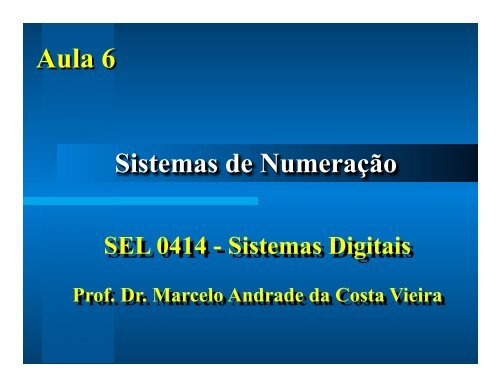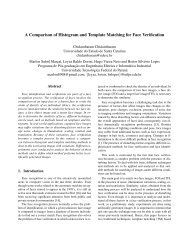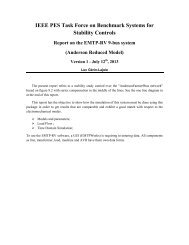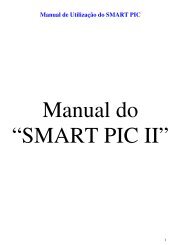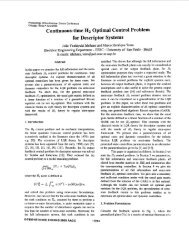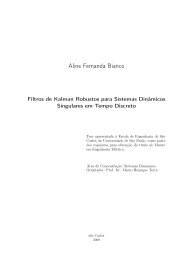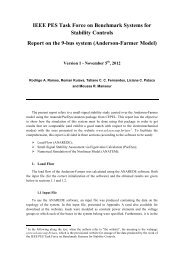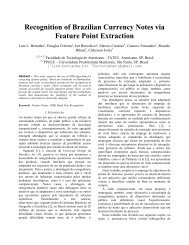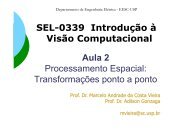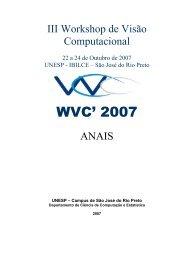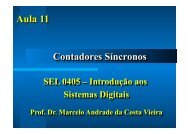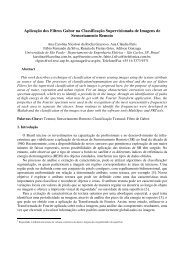Aula 6 - Sistemas de Numeracao - Iris.sel.eesc.sc.usp.br
Aula 6 - Sistemas de Numeracao - Iris.sel.eesc.sc.usp.br
Aula 6 - Sistemas de Numeracao - Iris.sel.eesc.sc.usp.br
Create successful ePaper yourself
Turn your PDF publications into a flip-book with our unique Google optimized e-Paper software.
<strong>Aula</strong> 6<<strong>br</strong> />
<strong>Sistemas</strong> <strong>de</strong> Numeração<<strong>br</strong> />
SEL 0414 - <strong>Sistemas</strong> Digitais<<strong>br</strong> />
Prof. Dr. Marcelo Andra<strong>de</strong> da Costa Vieira
<strong>Sistemas</strong> <strong>de</strong> Numeração<<strong>br</strong> />
1. SISTEMA DECIMAL<<strong>br</strong> />
• Composto por 10 símbolos ou numerais;<<strong>br</strong> />
• Base 10 0, 1, 2, 3, 4, 5, 6, 7, 8, 9.<<strong>br</strong> />
a n-1 ...a 3 a 2 a 1 a 0 = a n-1 10 n-1 +...+ a 3 10 3 + a 2 10 2 + a 1 10 1 + a 0 10 0<<strong>br</strong> />
Ex.: (4598) 10 = 4.10 3 + 5.10 2 + 9.10 1 + 8.10 0 =<<strong>br</strong> />
4000 + 500 + 90 + 8
<strong>Sistemas</strong> <strong>de</strong> Numeração<<strong>br</strong> />
1. SISTEMA DECIMAL
<strong>Sistemas</strong> <strong>de</strong> Numeração<<strong>br</strong> />
1. SISTEMA DECIMAL
<strong>Sistemas</strong> <strong>de</strong> Numeração<<strong>br</strong> />
2. SISTEMA BINÁRIO<<strong>br</strong> />
• Composto por 2 símbolos ou numerais;<<strong>br</strong> />
• Base 2 0, 1.<<strong>br</strong> />
b n-1 ...b 3 b 2 b 1 b 0 = b n-1 2 n-1 + ... + b 3 2 3 + b 2 2 2 + b 1 2 1 + b 0 2 0<<strong>br</strong> />
Ex.: (110100) 2 = 1.2 5 + 1.2 4 + 0.2 3 + 1.2 2 + 0.2 1 + 0.2 0<<strong>br</strong> />
l Definições:<<strong>br</strong> />
Dígito Binário (Binary Digit ou Bit)<<strong>br</strong> />
Nibble – 4 dígitos binários (4 Bits)<<strong>br</strong> />
Byte – 8 dígitos binários (8 Bits)
<strong>Sistemas</strong> <strong>de</strong> Numeração<<strong>br</strong> />
2. SISTEMA BINÁRIO<<strong>br</strong> />
Contagem <strong>de</strong> 0 a (2 N -1)
<strong>Sistemas</strong> <strong>de</strong> Numeração<<strong>br</strong> />
2. SISTEMA BINÁRIO<<strong>br</strong> />
“Most Significant Bit” “Less Significant Bit”
<strong>Sistemas</strong> <strong>de</strong> Numeração<<strong>br</strong> />
1. BINÁRIO DECIMAL<<strong>br</strong> />
CONVERSÃO ENTRE SISTEMAS<<strong>br</strong> />
DE NUMERAÇÃO<<strong>br</strong> />
110100<<strong>br</strong> />
(110100) 2 = 1.2 5 + 1.2 4 + 0.2 3 + 1.2 2 + 0.2 1 + 0.2 0 =<<strong>br</strong> />
= 32 + 16 + 4 = (52) 10
<strong>Sistemas</strong> <strong>de</strong> Numeração<<strong>br</strong> />
CONVERSÃO ENTRE SISTEMAS<<strong>br</strong> />
DE NUMERAÇÃO<<strong>br</strong> />
2. DECIMAL BINÁRIO<<strong>br</strong> />
Ex.: (49) 10 à (?) 2<<strong>br</strong> />
(49) 10 = (110001) 2
Técnica para Conversão <strong>de</strong><<strong>br</strong> />
Decimal para Binário<<strong>br</strong> />
121 =<<strong>br</strong> />
1111001<<strong>br</strong> />
121 2<<strong>br</strong> />
1 60 2<<strong>br</strong> />
0 30 2<<strong>br</strong> />
0 15 2<<strong>br</strong> />
1 7 2<<strong>br</strong> />
1 3 2<<strong>br</strong> />
1 1
<strong>Sistemas</strong> <strong>de</strong> Numeração<<strong>br</strong> />
BINÁRIO DECIMAL<<strong>br</strong> />
CONVERSÃO ENTRE SISTEMAS<<strong>br</strong> />
DE NUMERAÇÃO<<strong>br</strong> />
Com dígitos após a vírgula (números não inteiros)<<strong>br</strong> />
Ex. 11110,01<<strong>br</strong> />
(11110,01) 2 = 1.2 4 +1.2 3 +1.2 2 +1.2 1 +0.2 0 +0.2 -1 +1.2 -2<<strong>br</strong> />
= 16 + 8 + 4 + 2 + 0,25 = (30,25) 10
<strong>Sistemas</strong> <strong>de</strong> Numeração<<strong>br</strong> />
DECIMAL BINÁRIO<<strong>br</strong> />
CONVERSÃO ENTRE SISTEMAS<<strong>br</strong> />
DE NUMERAÇÃO<<strong>br</strong> />
Com dígitos após a vírgula (números não inteiros)<<strong>br</strong> />
• Calcula-se a conversão da parte inteira e da parte<<strong>br</strong> />
fracionária separadamente;<<strong>br</strong> />
• Para a parte fracionária, utiliza-se o método das<<strong>br</strong> />
multiplicações sucessivas:<<strong>br</strong> />
• Multiplica-se o nº fracionário por 2.<<strong>br</strong> />
• Desse resultado, a parte inteira será utilizada como<<strong>br</strong> />
dígito binário e a parte fracionária restante é<<strong>br</strong> />
novamente multiplicada por 2.<<strong>br</strong> />
• Repete-se o processo até que a parte fracionária do<<strong>br</strong> />
último produto seja igual a zero.
<strong>Sistemas</strong> <strong>de</strong> Numeração<<strong>br</strong> />
CONVERSÃO ENTRE SISTEMAS<<strong>br</strong> />
DE NUMERAÇÃO<<strong>br</strong> />
DECIMAL BINÁRIO<<strong>br</strong> />
Com dígitos após a vírgula (números não inteiros)<<strong>br</strong> />
Ex. 4,1875<<strong>br</strong> />
(4) 10 = (100) 2<<strong>br</strong> />
(0,1875) 10 = 0,1875 x 2 = 0,3750 = 0 + 0,3750<<strong>br</strong> />
0,3750 x 2 = 0,7500 = 0 + 0,7500<<strong>br</strong> />
0,7500 x 2 = 1,5000 = 1 + 0,5000<<strong>br</strong> />
0,5000 x 2 = 1,0000 = 1 + 0,0000<<strong>br</strong> />
= (0011) 2<<strong>br</strong> />
(4,1875) 10 = (100,0011) 2
<strong>Sistemas</strong> <strong>de</strong> Numeração<<strong>br</strong> />
3. SISTEMA OCTAL<<strong>br</strong> />
• Composto por 8 símbolos ou numerais;<<strong>br</strong> />
• Base 8 0, 1, 2, 3, 4, 5, 6, 7.<<strong>br</strong> />
o n-1 ...o 3 o 2 o 1 o 0 = o n-1 8 n-1 + ... + o 3 8 3 + o 2 8 2 + o 1 8 1 + o 0 8 0<<strong>br</strong> />
Ex.: (372) 8 = 3.8 2 + 7.8 1 + 2.8 0 = (250) 10
Conversão <strong>de</strong> Decimal para Octal<<strong>br</strong> />
(179) 10 = ?<<strong>br</strong> />
l Exemplo: Resposta:<<strong>br</strong> />
179 8<<strong>br</strong> />
3 22 8 (263) 8<<strong>br</strong> />
6 2
Conversão <strong>de</strong> Octal para Decimal<<strong>br</strong> />
l Exemplo: 274<<strong>br</strong> />
(274) 8 =<<strong>br</strong> />
2<<strong>br</strong> />
2 x 8 = 128 128 +<<strong>br</strong> />
1<<strong>br</strong> />
7 x 8 = 56 56 +<<strong>br</strong> />
0<<strong>br</strong> />
4 x 8 = 4 4 +<<strong>br</strong> />
(188) 10
Conversão <strong>de</strong> Binário para Octal<<strong>br</strong> />
e Vice-Versa<<strong>br</strong> />
Binário Octal<<strong>br</strong> />
000 0<<strong>br</strong> />
001 1<<strong>br</strong> />
010 2<<strong>br</strong> />
011 3<<strong>br</strong> />
100 4<<strong>br</strong> />
101 5<<strong>br</strong> />
110 6<<strong>br</strong> />
111 7<<strong>br</strong> />
l Como 8 é a terceira<<strong>br</strong> />
potência <strong>de</strong> 2, po<strong>de</strong>-se<<strong>br</strong> />
converter <strong>de</strong> octal em<<strong>br</strong> />
binário transformando<<strong>br</strong> />
cada dígito octal em seu<<strong>br</strong> />
equivalente com 3<<strong>br</strong> />
dígitos binários.
Conversão <strong>de</strong> Octal para Binário<<strong>br</strong> />
• Exemplo ð 257<<strong>br</strong> />
2 5 7<<strong>br</strong> />
<<strong>br</strong> />
010 101 111<<strong>br</strong> />
l Resposta 010 101 111
Conversão <strong>de</strong> Binário para Octal<<strong>br</strong> />
l A conversão <strong>de</strong> binário para octal é o<<strong>br</strong> />
inverso dos procedimentos acima;<<strong>br</strong> />
l Agrupe os bits <strong>de</strong> três em três, e<<strong>br</strong> />
converta cada grupo em seu<<strong>br</strong> />
equivalente octal;<<strong>br</strong> />
l Se houver necessida<strong>de</strong>, adicione zeros<<strong>br</strong> />
à esquerda do número binário.
Conversão <strong>de</strong> Binário para Octal<<strong>br</strong> />
Exemplo ð 10101111<<strong>br</strong> />
010 101 111<<strong>br</strong> />
<<strong>br</strong> />
2 5 7<<strong>br</strong> />
l Resposta 257
Sequência <strong>de</strong> Números Octal<<strong>br</strong> />
0 14 30 104<<strong>br</strong> />
1 15 31 105<<strong>br</strong> />
2 16 .... ....<<strong>br</strong> />
3 17 .... ....<<strong>br</strong> />
4 20 .... ....<<strong>br</strong> />
5 21 75 776<<strong>br</strong> />
6 22 76 777<<strong>br</strong> />
7 23 77 1000<<strong>br</strong> />
10 24 100 1001<<strong>br</strong> />
11 25 101 ....<<strong>br</strong> />
12 26 102 ....<<strong>br</strong> />
13 27 103 ....
<strong>Sistemas</strong> <strong>de</strong> Numeração<<strong>br</strong> />
4. SISTEMA HEXADECIMAL<<strong>br</strong> />
• Composto por 16 símbolos ou numerais;<<strong>br</strong> />
• Base 16 0, 1, 2, 3, 4, 5, 6, 7, 8, 9, A, B, C, D, E, F.<<strong>br</strong> />
h n-1 ...h 3 h 2 h 1 h 0 = h n-1 16 n-1 +...+ h 3 16 3 + h 2 16 2 + h 1 16 1 + h 0 16 0<<strong>br</strong> />
Ex.: (1A7) 16 = 1.16 2 + 10.16 1 + 7.16 0 = (423) 10
Conversão <strong>de</strong> Decimal em Hexa<<strong>br</strong> />
l Exemplo:<<strong>br</strong> />
9 9<<strong>br</strong> />
2479 16 10 A<<strong>br</strong> />
15 154 16 15 F<<strong>br</strong> />
10 9<<strong>br</strong> />
9AF
Conversão <strong>de</strong> Hexa para Decimal<<strong>br</strong> />
l Exemplo: 9AF<<strong>br</strong> />
2<<strong>br</strong> />
9 x 16 = 2304 2304 +<<strong>br</strong> />
1<<strong>br</strong> />
A x 16 = 160 160 +<<strong>br</strong> />
0<<strong>br</strong> />
F x 16 = 15 15 +<<strong>br</strong> />
2479
Conversão <strong>de</strong> Hexa para Binário<<strong>br</strong> />
l Para converter um número hexa<strong>de</strong>cimal em<<strong>br</strong> />
um número binário, converta cada dígito<<strong>br</strong> />
hexa<strong>de</strong>cimal em seu equivalente <strong>de</strong> 4 bits;<<strong>br</strong> />
l A vantagem do sistema hexa<strong>de</strong>cimal, é<<strong>br</strong> />
po<strong>de</strong>r agrupar cada conjunto <strong>de</strong> 4 dígitos<<strong>br</strong> />
binários em apenas 1 dígito hexa;<<strong>br</strong> />
l Muito utilizado em en<strong>de</strong>reçamento <strong>de</strong><<strong>br</strong> />
memória.
Números Hexa<strong>de</strong>cimais<<strong>br</strong> />
Dec Binário Hexa<<strong>br</strong> />
0 0000 0<<strong>br</strong> />
1 0001 1<<strong>br</strong> />
2 0010 2<<strong>br</strong> />
3 0011 3<<strong>br</strong> />
4 0100 4<<strong>br</strong> />
5 0101 5<<strong>br</strong> />
6 0110 6<<strong>br</strong> />
7 0111 7<<strong>br</strong> />
Dec Binário Hexa<<strong>br</strong> />
8 1000 8<<strong>br</strong> />
9 1001 9<<strong>br</strong> />
10 1010 A<<strong>br</strong> />
11 1011 B<<strong>br</strong> />
12 1100 C<<strong>br</strong> />
13 1101 D<<strong>br</strong> />
14 1110 E<<strong>br</strong> />
15 1111 F
Conversão <strong>de</strong> Hexa para Binário<<strong>br</strong> />
9AF<<strong>br</strong> />
9 A F<<strong>br</strong> />
<<strong>br</strong> />
1001 1010 1111<<strong>br</strong> />
l Resposta 100110101111
Conversão <strong>de</strong> Binário em Hexa<<strong>br</strong> />
Exemplo 1110101101<<strong>br</strong> />
0011 1010 1101<<strong>br</strong> />
<<strong>br</strong> />
3 A D<<strong>br</strong> />
l Resposta 3AD
Sequência <strong>de</strong> Números Hexa<strong>de</strong>cimal<<strong>br</strong> />
0 C 18 99 FA 9FD<<strong>br</strong> />
1 D 19 9A FB 9FE<<strong>br</strong> />
2 E 1A 9B FC 9FF<<strong>br</strong> />
3 F 1B 9C FD A00<<strong>br</strong> />
4 10 1C 9D FE A01<<strong>br</strong> />
5 11 1D 9E FF .....<<strong>br</strong> />
6 12 1E 9F 100 .....<<strong>br</strong> />
7 13 1F A0 101 FFE<<strong>br</strong> />
8 14 20 A1 102 FFF<<strong>br</strong> />
9 15 ... ... .... 1000<<strong>br</strong> />
A 16 ... ... .... 1001<<strong>br</strong> />
B 17 98 F9 9FC .......
Código BCD<<strong>br</strong> />
DECIMAL BINÁRIO ou BINÁRIO DECIMAL<<strong>br</strong> />
l Muito complicado na prática<<strong>br</strong> />
l Hardware complexo<<strong>br</strong> />
l Binário Puro<<strong>br</strong> />
Alternativa:<<strong>br</strong> />
l Uso <strong>de</strong> um Código<<strong>br</strong> />
l Decimal codificado em Binário
Funções Códigos/Decodificadores<<strong>br</strong> />
Lógicas<<strong>br</strong> />
1. CÓDIGO BCD (Binary-Co<strong>de</strong>d Decimal)<<strong>br</strong> />
l Cada dígito <strong>de</strong>cimal é representado por um<<strong>br</strong> />
“código” equivalente em binário;<<strong>br</strong> />
l Não é um sistema <strong>de</strong> numeração;<<strong>br</strong> />
l É diferente <strong>de</strong> conversão em binário puro;<<strong>br</strong> />
l Quantos bits?<<strong>br</strong> />
l 4 bits<<strong>br</strong> />
l 16 códigos possíveis → só se usa 10 para<<strong>br</strong> />
o sistema <strong>de</strong>cimal
Código BCD 8421<<strong>br</strong> />
Decimal Binário<<strong>br</strong> />
0 0000<<strong>br</strong> />
1 0001<<strong>br</strong> />
2 0010<<strong>br</strong> />
3 0011<<strong>br</strong> />
4 0100<<strong>br</strong> />
5 0101<<strong>br</strong> />
6 0110<<strong>br</strong> />
7 0111<<strong>br</strong> />
Decimal Binário<<strong>br</strong> />
8 1000<<strong>br</strong> />
9 1001<<strong>br</strong> />
10 1010<<strong>br</strong> />
11 1011<<strong>br</strong> />
12 1100<<strong>br</strong> />
13 1101<<strong>br</strong> />
14 1110<<strong>br</strong> />
15 1111<<strong>br</strong> />
Não<<strong>br</strong> />
Utilizado
Funções Códigos/Decodificadores<<strong>br</strong> />
Lógicas<<strong>br</strong> />
1. CÓDIGO BCD 8421 X Número Binário<<strong>br</strong> />
Decimal Binário BCD (8421)<<strong>br</strong> />
0<<strong>br</strong> />
1<<strong>br</strong> />
2<<strong>br</strong> />
3<<strong>br</strong> />
4<<strong>br</strong> />
5<<strong>br</strong> />
6<<strong>br</strong> />
7<<strong>br</strong> />
8<<strong>br</strong> />
9<<strong>br</strong> />
10<<strong>br</strong> />
11<<strong>br</strong> />
12<<strong>br</strong> />
...<<strong>br</strong> />
98<<strong>br</strong> />
99<<strong>br</strong> />
100<<strong>br</strong> />
101<<strong>br</strong> />
...<<strong>br</strong> />
578<<strong>br</strong> />
...<<strong>br</strong> />
0<<strong>br</strong> />
1<<strong>br</strong> />
10<<strong>br</strong> />
11<<strong>br</strong> />
100<<strong>br</strong> />
101<<strong>br</strong> />
110<<strong>br</strong> />
111<<strong>br</strong> />
1000<<strong>br</strong> />
1001<<strong>br</strong> />
1010<<strong>br</strong> />
1011<<strong>br</strong> />
1100<<strong>br</strong> />
...<<strong>br</strong> />
1100010<<strong>br</strong> />
1100011<<strong>br</strong> />
1100100<<strong>br</strong> />
1100101<<strong>br</strong> />
...<<strong>br</strong> />
1001000010<<strong>br</strong> />
...<<strong>br</strong> />
0000<<strong>br</strong> />
0001<<strong>br</strong> />
0010<<strong>br</strong> />
0011<<strong>br</strong> />
0100<<strong>br</strong> />
0101<<strong>br</strong> />
0110<<strong>br</strong> />
0111<<strong>br</strong> />
1000<<strong>br</strong> />
1001<<strong>br</strong> />
0001 0000<<strong>br</strong> />
0001 0001<<strong>br</strong> />
0001 0010<<strong>br</strong> />
...<<strong>br</strong> />
1001 1000<<strong>br</strong> />
1001 1001<<strong>br</strong> />
0001 0000 0000<<strong>br</strong> />
0001 0000 0001<<strong>br</strong> />
...<<strong>br</strong> />
0101 0111 1000<<strong>br</strong> />
...
Outros Códigos BCD
Conversão <strong>de</strong> Decimal para BCD<<strong>br</strong> />
l Exemplo 137<<strong>br</strong> />
1 3 7<<strong>br</strong> />
<<strong>br</strong> />
0001 0011 0111<<strong>br</strong> />
l Resposta<<strong>br</strong> />
(000100110111) BCD 12 bits<<strong>br</strong> />
l Em Binário (10001001) 2<<strong>br</strong> />
8 bits
Exercícios<<strong>br</strong> />
1. (37) 10 => ( 100101 ) 2<<strong>br</strong> />
2. (177) 10 => ( 261 ) 8 => ( 010110001 ) 2<<strong>br</strong> />
3. (5431) 8 => ( B19 ) 16 => ( 0010100001000001 ) BCD<<strong>br</strong> />
4. (214) 10 => ( D6 ) 16 => ( 11010110 ) 2
FIM


